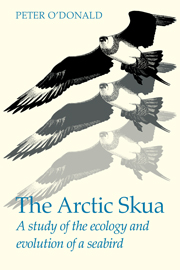Book contents
- Frontmatter
- Contents
- List of figures
- List of tables
- Preface
- 1 The Arctic Skuas of Fair Isle
- 2 Numbers and distribution
- 3 Feeding behaviour and ecology
- 4 Breeding ecology
- 5 Genetics
- 6 Demography and selection
- 7 Sexual behaviour
- 8 Sexual selection
- 9 Genetic models of sexual selection in birds
- 10 Mating preferences of the Arctic Skua
- 11 Conclusions
- Appendix A Rates of increase of bird populations
- Appendix B Analysis of variance of a 2 × r table with unequal numbers of observations
- Appendix C Statistical analysis of assortative and disassortative mating in polymorphic birds
- References
- Index
6 - Demography and selection
Published online by Cambridge University Press: 21 May 2010
- Frontmatter
- Contents
- List of figures
- List of tables
- Preface
- 1 The Arctic Skuas of Fair Isle
- 2 Numbers and distribution
- 3 Feeding behaviour and ecology
- 4 Breeding ecology
- 5 Genetics
- 6 Demography and selection
- 7 Sexual behaviour
- 8 Sexual selection
- 9 Genetic models of sexual selection in birds
- 10 Mating preferences of the Arctic Skua
- 11 Conclusions
- Appendix A Rates of increase of bird populations
- Appendix B Analysis of variance of a 2 × r table with unequal numbers of observations
- Appendix C Statistical analysis of assortative and disassortative mating in polymorphic birds
- References
- Index
Summary
The demographer collects data of birth and death rates so that he can predict population trends and changes. He needs to know the probabilities of surviving to different ages and the mean number of offspring born to individuals in each age class. Such data are very difficult to obtain except from human populations. Ideally, the probabilities of survival should be estimated by the proportions of survivors of a cohort of individuals who have been followed from birth until all have died.
Human populations consist of individuals of all ages. Reproduction is continuous. Many organisms reproduce annually at a particular time of the year. A population can then be divided into separate age classes. When the chicks have hatched in a population of birds, for example, individuals may be 0, 1, 2, … or x years old, having either just hatched, or hatched last year, or two years ago or, in general, x years ago. Birds are easily counted or caught for ringing in the breeding season. This is convenient because they are thus counted when almost exactly 0, 1, 2, … or x years old.
The demography of a population is usually described in terms of a standard set of symbols. The symbols l0, l1, l2, … lx, denote the probabilities of surviving for 0, 1, 2, … or x years. Obviously, l0, = 1, since the new-born have had no time to die.
- Type
- Chapter
- Information
- The Arctic SkuaA study of the ecology and evolution of a seabird, pp. 120 - 144Publisher: Cambridge University PressPrint publication year: 1983



